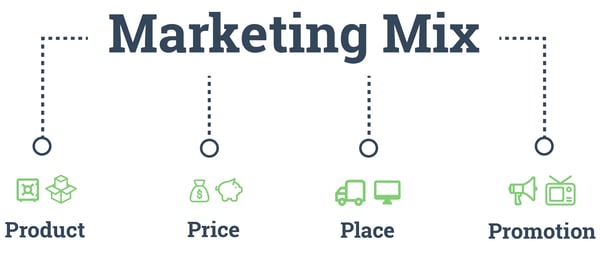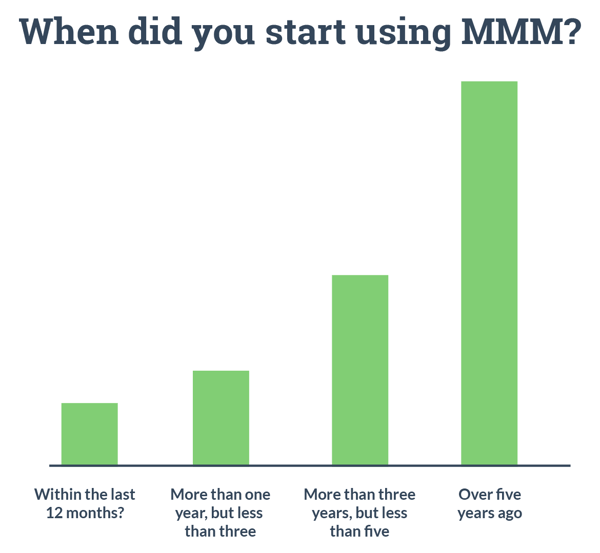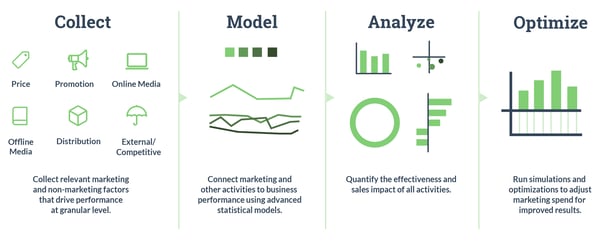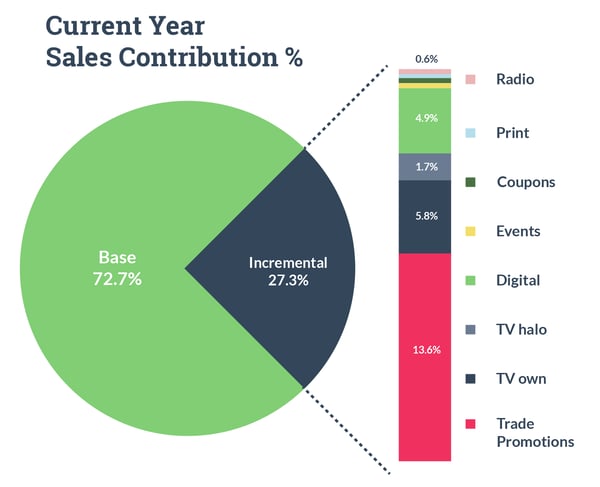What is Marketing Mix Modelling? 3 Benefits & Limitations
There was a time when we considered traditional marketing practices, and the successes or failures they yield, as an art form. With mysterious, untraceable results, marketing efforts lacked-transparency and were widely regarded as being born out of the creative talents of star marketing professionals.
The advent of big data changed things; substantial investment in data collection and analysis in the 1980s saw a shift in thinking toward marketing as being at least partly, if not wholly, scientific. To many marketers, however, the shift toward a full-blown scientific approach has been overwhelming. The new technologies, complex algorithms, and statistical applications often leave us scrambling to keep up.
In retail industries, only 8-10% of sales revenue goes toward marketing activity; leaving CMOs and marketing managers to face the issue of how and where to invest their limited marketing budgets. Understandably, the biggest concern is how best to allocate this budget to a wide range of marketing activities. Methodical, strategic planning in the form of Marketing Mix Modelling (MMM) can help you overcome this problem, by finding the optimal mix of marketing variables and proving the return of investment (ROI) that your painstakingly-researched marketing strategy provides.
What is Marketing Mix Modelling (MMM)?
We all know about the 4Ps of the marketing mix: Product, Price, Place, Promotion. It’s a fundamental part of marketing theory that considers what factors are required for a business to succeed.

Well, marketing mix modelling is closely related to the 4Ps in that it seeks to determine how much success was generated by each factor, and forecast what future success can be created through altering and optimising the marketing mix.
Marketing mix modelling is a statistical method of determining the effectiveness of marketing campaigns by breaking down aggregate data and differentiating between contributions from marketing tactics and promotional activities, and other uncontrollable drivers of success.
The results, or ‘output’, of your marketing mix model analysis, will then inform the composition of future marketing efforts with a level of certainty, i.e. to change input ‘a’ will affect output ‘b.’
Benefits of Marketing Mix Modelling
- Enables marketers to prove the ROI of their efforts
- Returns insights that allow for effective budget allocation
- Facilitates superior sales trend forecasting
Limitations of Marketing Mix Modelling
- Lacks the convenience of real-time modern data analytics
- Critics argue that modern attribution methods are more effective as they consider 1 to 1, individual data
- Marketing Mix Modelling does not analyse customer experience (CX)
How to get started with Marketing Mix Modelling?
Okay, right now, I could get stuck into equations and coefficients and, you know, all the things that generally made you want to cry in high school mathematics class. But the thing is, as a marketing executive or manager, you’re far more likely to be pitching the benefits of implementing marketing mix modelling than actually crunching the numbers yourself... *phew*.
So, instead, here’s what you need to know when trying to get a marketing mix modelling project off the ground within your department, so you can leave all the confusing stuff to the pros.

Source: iab
Google suggests that before undertaking any Marketing Mix Modelling within your business or with a vendor, you need to prepare your organisation for what is to come. By following their 4 steps, you will ensure that your organisation gains value from your MMM project:
Step 1: Establish goals
Remember, the whole reason to undertake MMM in the first place is to gain systematic knowledge that will enhance your marketing efforts and optimise your budget allocation. But beyond this, your organisational goals need to be clear and achievable.
Outline the key questions you want to answer through your marketing mix modelling. Some examples of areas to examine and questions to ask yourself may include:
- Budget
Which marketing tactics have the best median return on investments (MROI)?
- Media
Would increasing the TV advertising budget by 15% increase our incremental sales?
- Pricing
What is the impact of a price change on sales and profits?
- Competitive
Which competitors’ advertising campaigns are having the most significant impact on sales?
The questions you ask your organisation during the preparation stages will subsequently guide the size and range of your MMM analysis and will help you to understand what data is needed to carry out your plans.
Step 2: Align your organisation and key stakeholders to understand the data
Marketing mix modelling requires you to collect a large amount of data from several different areas within your organisation. To do this, you will need to engage the gatekeepers of each data set, establish responsibilities, and create a timeline for data processing.
Any number of these figures will likely need to be engaged:
- CMO (Chief Marketing Officer)
- TV and media agency partners
- Marketing agency partners
- CRM manager
- Marketing executives
Step 3: Identify relevant data
Your organisation will have existing data repositories; this is where your company and customer data is held to be easily accessed and analysed for research purposes. The quality of your data is an essential factor for MMM; data that is consistent, clean, and stored logically will save you time and effort when it comes to repurposing for your analysis. At this stage, you should enlist the help of any colleague responsible for managing organisational data repositories and tools.
Step 4: Understand your access to data, including any limitations
Create a detailed inventory of the data you hold and wish to involve in your analysis; try to gather as much information as possible, including any payments or subscriptions required to access third party data. You will also need to account for any time delays associated with accessing offline data.
How to conduct marketing mix modelling?
Nielsen points to 4 stages of the Marketing Mix Modelling process:

Source: Nielsen
Stage 1: Collect
Within the collection stage of marketing mix modelling, econometric techniques are used to estimate product demand produced by marketing tactics by separating product sales into 2 types of sales drivers:
1. Incremental drivers
These are the controllable elements implemented by the marketing team. Incremental drivers run on a short-term basis; data is captured on week-to-week sales that vary depending on:
- Above-the-line media activity (TV, print ads, digital ads, promotions, and discounts, etc.)
- Below-the-line factors (temporary selling prices, sales promotions, discounts, social media, direct mail marketing campaigns, in-store marketing, events, and conferences.)

2. Base drivers
The base outcome for a business is the sales that are achieved in the absence of any incremental marketing activity. Base outcomes are often the result of brand equity and reputation that has been built up over several years, for example, customer loyalty.
The following elements are base drivers:
- Price: The price of a product is a significant base driver of a marketing mix as price determines both the consumer segment that a product is targeted toward and the promotions which are implemented to market the product to the chosen audience.
- Distribution: The number of store locations, the stock within those locations, and the shelf life of that stock are all considered as base drivers of the marketing mix. Store locations and the inventory within them are static and can be discovered by customers without any marketing intervention.
- Seasonality: Certain variations happen periodically within a business year and can thus be relied upon to drive sales with a level of predictability. Seasonal sales, such as the winter holiday period, are huge drivers for the business. In 2018, for example, the eCommerce industry grew 16.7%, reaching up to $123.90 billion because of the holiday spending spree.
- Macroeconomic variables: macroeconomics is the study of how the overall economy and markets behave. It considers the impact of issues such as inflation, gross domestic product (GDP), unemployment, etc. When it comes to MMM, macroeconomic factors can have a significant impact on base sales, for example, an increase in unemployment rates will lower the purchasing power of consumers and, thus, sales will decrease.

Source: Exl Service
Stage 2: Model
P.M Cain calls the Time Series analysis (regression model) the “logical choice” for marketing mix modelling projects… If you’re scratching your head right now, don’t worry. Here’s a quick definition from the guys at MathWorks:
“Time series regression is a statistical method for predicting a future response based on the response history (known as autoregressive dynamics) and the transfer of dynamics from relevant predictors. Time series regression can help you understand and predict the behaviour of dynamic systems from experimental or observational data. Time series regression is commonly used for modelling and forecasting of economic, financial, and biological systems.”
Predicting the future sounds pretty cool, doesn’t it? Please, don’t tell anyone I said math was cool.
Time-series regression analysis involves creating many different intervals of time and corresponding business results within these periods. The model is based upon the concept of Adstock, which dates way back to 1979 and describes the non-linear relationship between advertising and consumer behaviour.
Adstock theory states that advertising is not immediate and has diminishing returns, meaning that its influential power decreases over time, even if more money is allocated to it. Therefore, time regression analysis will help marketers to understand the potential timeline for advertising effectiveness and how to optimise the marketing mix to compensate for these factors.
It should be noted that this is just one of many models; depending on your organisational goals, the quality of your data, and the vendor that you choose to work with, a different model may be implemented.
Stage 3: Analyse
In the analysis stage, the outputs of your chosen model will be examined; these outputs will come in the form of decomposition of sales, which breaks the data down into volume for each modelled tactic.
There are 3 significant metrics when it comes to analysing the decomposition of sales:
- Effectiveness
- Efficiency
- Median Return of Investment (MROI)
You will be able to gain information on these metrics for your marketing efforts as a whole, and for each tactic individually.

Source: Neilsen
Stage 4: Optimise
This final stage of MMM essentially sees you turn your outputs into inputs - full circle style; meaning, you use the results of your analysis to optimise your marketing mix for future campaigns.
Part of the optimisation will include a “what if” simulation. The outputs of your marketing model are equations that demonstrate the relationship between marketing activities and sales results. With these equations, you can predict what will happen if changes are made to the marketing mix.
For example, “what if” I decrease the price of Coca Cola cans by 5%. This question considers how changes to incremental factors such as promotional discounts will impact sales, and your model output will return an accurate answer, which you can use to inform your promotions strategy.

Source: Ashokcharan
Choosing a marketing mix modelling vendor
Now that you have a clearer understanding of what marketing mix modelling is and what can be achieved with it, you should begin to consider which vendor you will use to handle your modelling. Unless that is, you have a statistical analysis whiz kid in-house at your organisation, in which case, off you go!
During your research and consideration stages of finding the right vendor, here are some critical questions that you will want to ask:
- Question 1: Which sales drivers are included in the marketing mix model?
- Question 2: How is data collected?
- Question 3: What level of granularity are the data inputs?
- Question 4: How do you ensure the accuracy of the data inputs?
- Question 5: How granular are the insights?
Without a thorough investigation into the vendor, you could end up with an analysis that lacks creativity and runs overtime with unplanned delays. Or worst-case scenario, you could end up with inaccurate data which fails to drive the actionable insights that you need to increase revenue and ROI.
Summing Up
If carried out correctly, MMM has the potential to streamline your marketing mix through fact-based optimisation. Using statistical data removes the guesswork from marketing activity, increasing ROI through precisely allocated budgets and accurately accounting for seasonal and channel-specific factors.
In marketing, accurate data means more room to be creative with your content and more time to create a memorable customer experience (CX) for your audience. Investing in marketing mix modelling will give you the confidence to make decisive moves within your market and, ultimately, go further than your competitors.
If you’re struggling to become an omnichannel brand, why not book a demo of Hurree’s data unification and segmentation platform or email any of your questions to me at contact@hurree.co. It’s time to get your tools talking and we can help you do it!
Share this
You May Also Like
These Related Stories

Experiential Marketing: 4 Es to Future-proof Your Strategy

The 7Ps of The Marketing Mix: Streamline your Strategy



